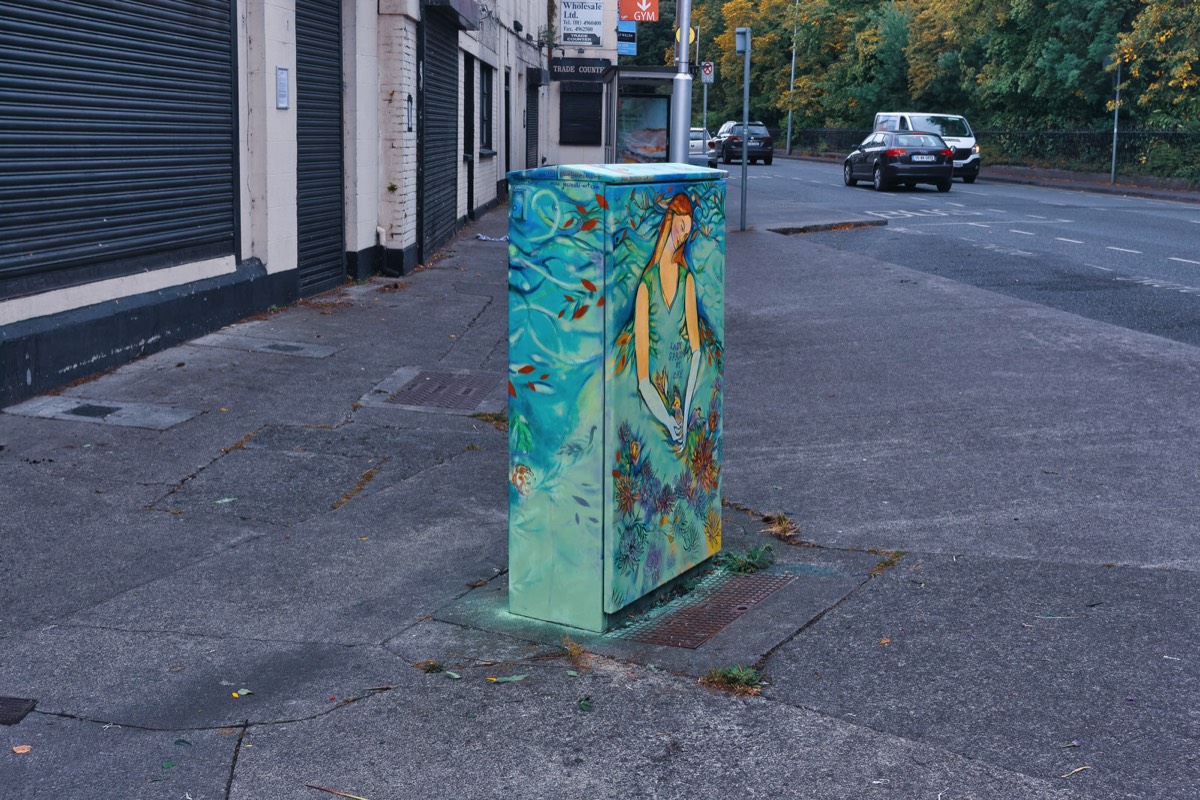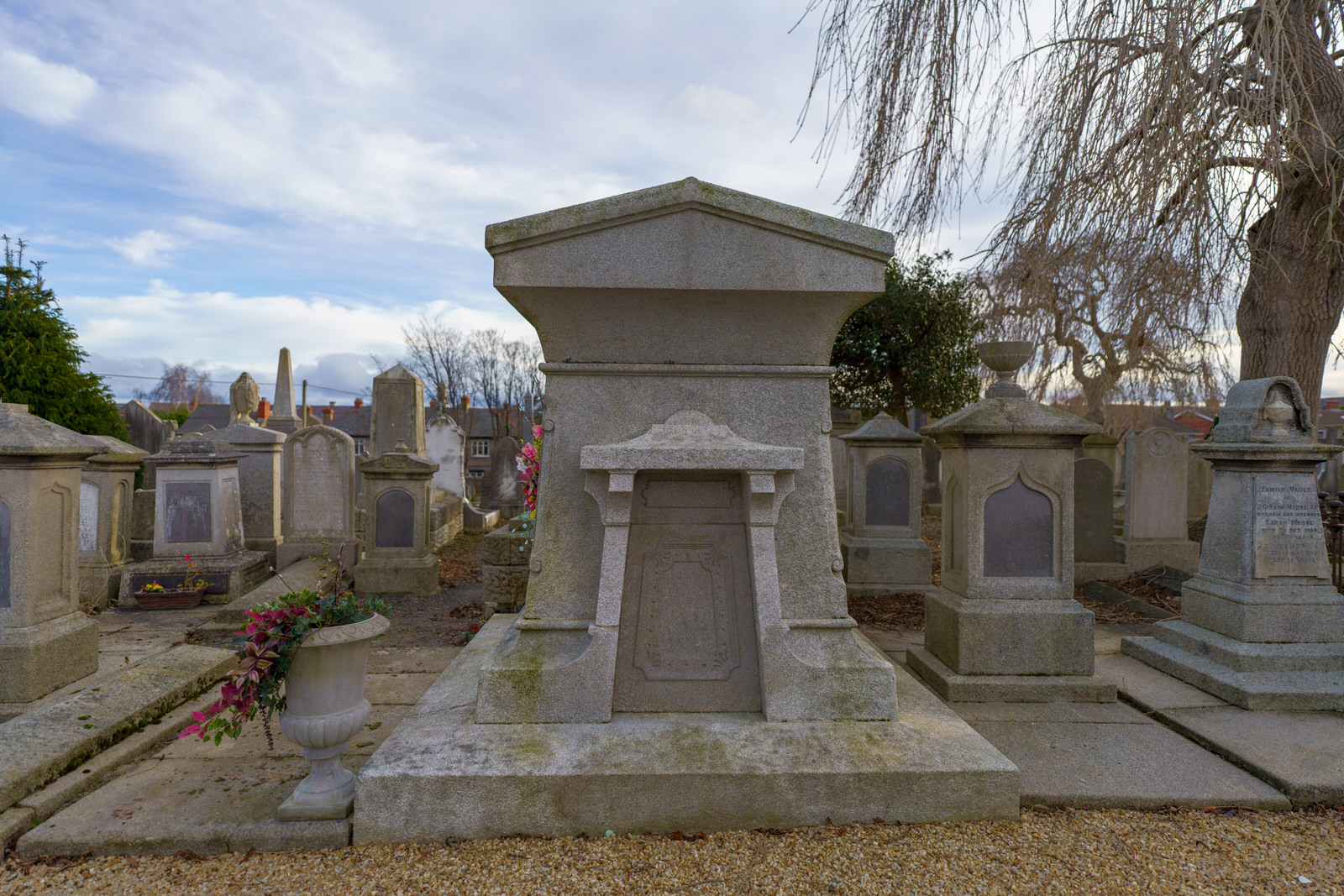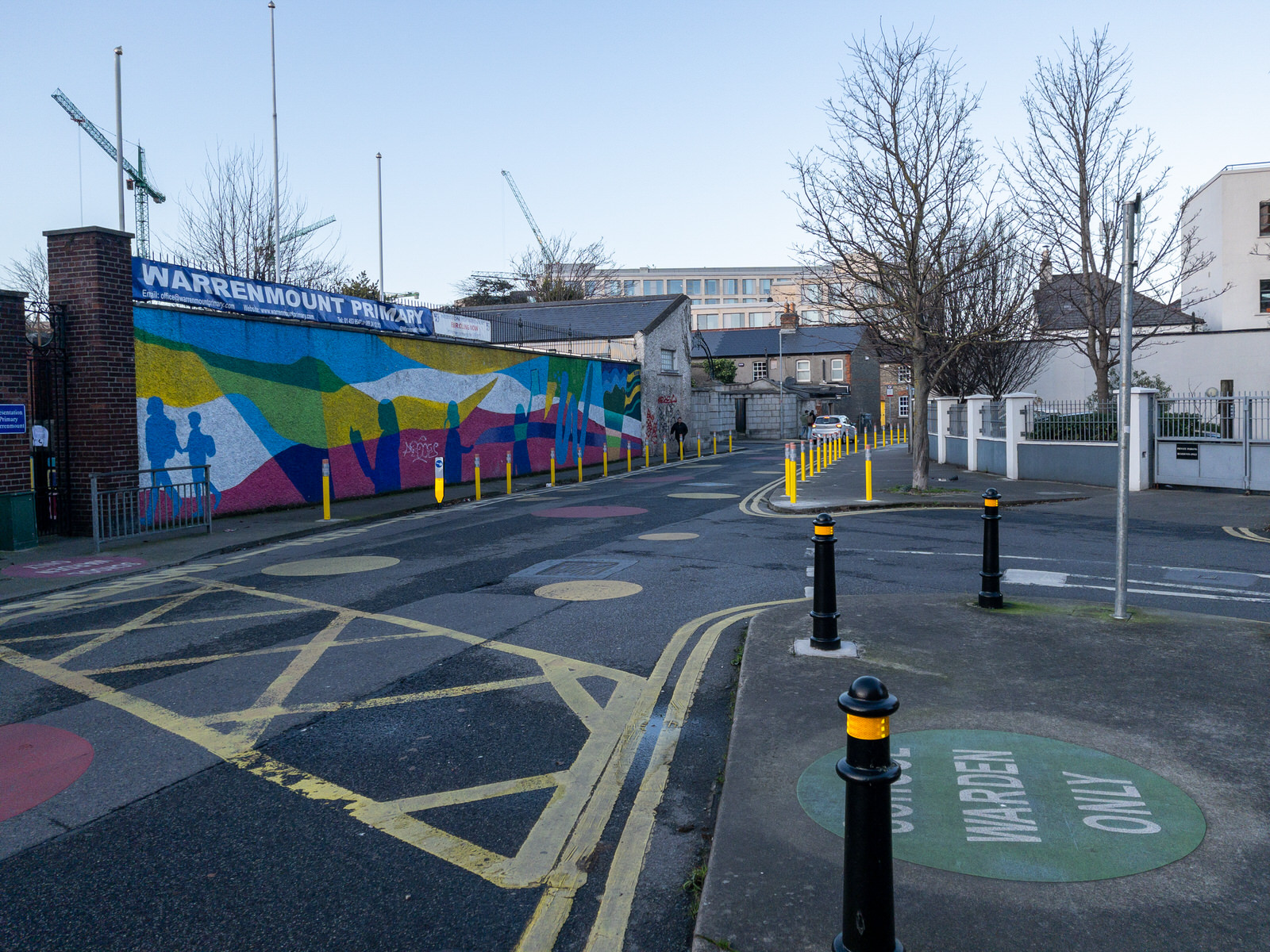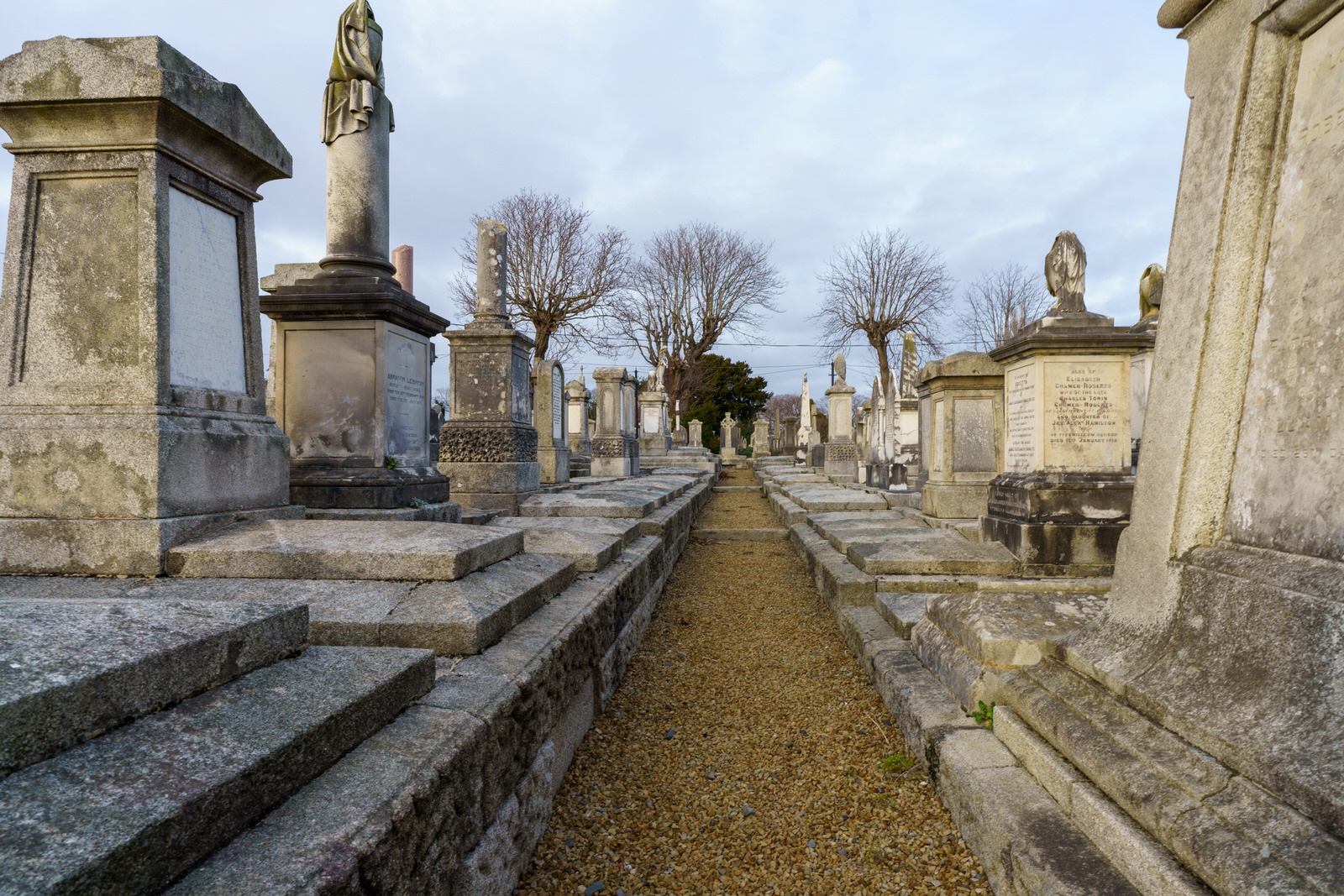HAROLD'S CROSSAREAS OF DUBLIN
MOUNT JEROME CEMETERY26 AUGUST 2022
I underexposed and then processed the images through DX0 PureRAW in order to reduce noise. The resulting files were then processed using Adobe Lightroom Classic.
The name of the cemetery comes from an estate established there by the Reverend Stephen Jerome, who in 1639 was vicar of St. Kevin's Parish. At that time, Harold's Cross was part of St. Kevin's Parish. In the latter half of the 17th century, the land passed into the ownership of the Earl of Meath, who in turn leased plots to prominent Dublin families.
LADY SPRING BY PAWEL JASINSKI PAINT-A-BOX STREET ART AT MOUNT JEROME
In December 2017, The Hunt Museum in Limerick recognised his painting "Woman at Temple Bar" as the picture of the month. Pawel also exhibited his works in the legendary place of Polish culture - Piwnica pod Baranami in Krakow.
HAROLD'S CROSS AREAPHOTOGRAPHED BY WILLIAM MURPHY
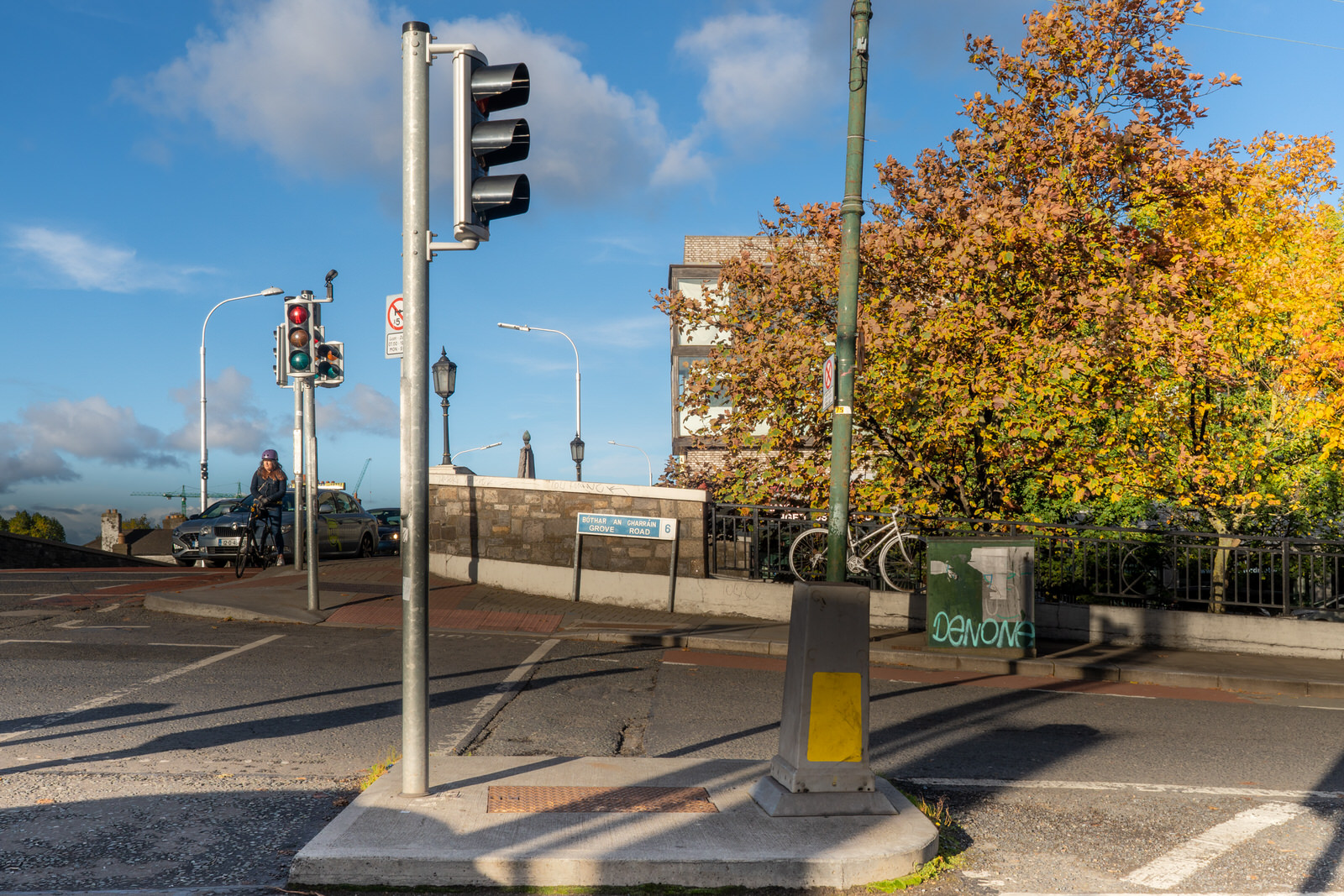
Harold's Cross is an urban village and inner suburb on the south side of Dublin, Ireland. The River Poddle runs through it, though largely in an underground culvert, and it holds both a major cemetery, Mount Jerome, and Our Lady's Hospice.
Harold's Cross is situated north of Terenure and Rathgar, west of Rathmines, east of Crumlin and Kimmage, and directly south from the Grand Canal at Clanbrassil Street. It lies within the jurisdiction of Dublin City Council, and straddles the boundary of Dublin 6, Dublin 6W and Dublin 12 postal districts.
The River Poddle runs south to north through the area. At the southern end of the district, the river's course splits at the centuries-old "Tongue" or "Stone Boat" with part of its flow diverted underground into the "City Watercourse" culvert, while the mainline continues overground, passing through ponds. The Poddle goes underground between Mount Argus and Mount Jerome, then flows along the cemetery boundary, including the Islamic plot, before going into a culvert at Greenmount, heading for the Grand Canal.
Irish Nationalist leader Robert Emmet was captured near Harold's Cross. He lived for a period in a house in Harold's Cross so he could be near his sweetheart Sarah Curran of Rathfarnham. He led an abortive rebellion against British rule in 1803 and was captured, tried and executed. The Grand Canal bridge linking Harold's Cross Road and Clanbrassil Street was named in his honour and a plaque there commemorates him (the bridge was formerly called Clanbrassil Bridge, and is known locally as Harold's Cross Bridge).
The father of Patrick Pearse (Pádraic Mac Piarais), James, was a stonemason for Mount Argus Church. The Pearse family had a long association with the Passionists and Mount Argus. Both Patrick and Willie Pearse came for confessions on the day of the Easter Rising. Mrs Pearse and Patrick himself also taught Irish language lessons in the community Scout Hall next to the church.[16] The 1916 Volunteers, who had a training ground in nearby Kimmage, are said to have paid a visit to Mount Argus Church to pray just before taking part in the 1916 Easter Rising.
O'Connor's Jewellers on Harold's Cross Road is noted for being the victim of one of the two famous robberies carried out by the notorious Dublin criminal Martin Cahill, "The General" (who is also buried in Mount Jerome Cemetery).
Honour Bright, a prostitute (real name Elizabeth (Lily) O'Neill) was murdered in June 1925, and her body found in the mountains. Witnesses last saw her alive at Leonards' Corner, just to the north of Harolds' Cross. Dr Patrick Purcell, a medical doctor in County Wicklow, and Leopold J. Dillon, a Garda, were put on trial charged with the murder but were acquitted. The murderer was never traced.
There was a well established community of Quakers in Harold's Cross that operated a number of industries in the locality including cotton, paper and flour milling during the 19th century. They also ran a number of orphanages locally. Among these industries was the Greenmount Spinning manufacturing powered by the River Poddle, owned by the well-known Pim family. James Pim was commonly known as the "Quaker father of Irish railways.
Quaker brothers Thomas Pim and Robert Goodbody decided to relocate Goodbody Tobacco manufacturing to Greenville near Harolds Cross after a disastrous fire in their Tullamore premises in 1886; as a result, most of their employees were also relocated to the area, where red brick terrace housing was built in the area by the Dublin Artizans' Dwellings Company, in which the Pim family were prominent members.
FINDLATER FAMILY VAULTMOUNT JEROME CEMETERY
May 30th 2019 Alex Findlater died following a riding accident in Punjab, India.
In 1823 Alex. Findlater & Co. began trading in Dublin. The company was founded by Alexander Findlater, a hard working spirit merchant. He set up his business on Burgh Quay opposite the Custom House. From humble beginnings, the business grew rapidly and extensively not just in Dublin but into the United Kingdom also, expanding into other fields; trading in Wines, Teas, Coffees and Groceries.
In Dublin, the Findlaters prospered. By 1906, the company had expanded into groceries, tea and provisions, with 14 shops. They built Findlater’s Church on Parnell Square, as well as the Todd Burns department store on Mary Street. Their Mountjoy Brewery, established in 1852, was Dublin’s second-largest exporter of stout by 1866. They also operated hotels in Howth and Bray.
WARRENMOUNT PRIMARY SCHOOLPENCIL SHAPED BOLLARDS
Today I photographed Fumbally Lane, Mapas Terrace, Mapas Place, Mapas Street, Blackpitts, Greenville Parade, St. John's Street, St. Michael's Terrace Hammond Street and adjoining lanes.
Fumbally Lane is a narrow and historic street in Dublin, Ireland, south of the city centre in The Liberties. It connects Blackpitts to New Street and is close to St Patrick’s Cathedral.
Substantial physical evidence of the 18th & 19th century brewing and distilling industry buildings remain on both sides of the lane today, including storehouses and a five-storey malthouse. Most of these remnants of its industrial past have been converted to modern office use.
Today, Fumbally Lane is home to dozens of people living in new apartments and in mainly 19th-century houses, although three possibly date to the late 18th century. It is also home to clusters of mainly design creative businesses based in Fumbally Court which is a large 19th-century distillery building, remodelled as offices c 1990 and Fumbally Square, a development of new office space developed in 2005. The street remains a ’unique remnant of the mixed residential and industrial architecture that characterised the area’
A number of local enterprises have borrowed the Fumbally name including the Fumbally Café and Fumbally Exchange, a non-profit community of design professionals founded in Fumbally Square in 2010.
The name Fumbally is a peculiar one and a name that has provoked a wide range of theories and suggestions as to its origin. The street is officially called Fumbally Lane today or Lána Fumbally. It has not always been called that and has had many name variations since 1721.
The lane first appears in Charles Brooking's map of 1728 without a name and with variations in subsequent maps including John Rocque's map of 1756 as 'Bumbailiff’s Lane' and in Wilson's map of 1798 as 'Fumbailie’s Lane'. It is mistakenly suggested by the Rev. Mr. McCready in Dublin Street Names: Dated and Explained that Fumbally’s Lane (as it was then referred to in Thom's Directory) was just a ‘corruption of Bumbailiff's-lane’. Fumbally's Lane is also the name James Joyce uses in chapter 3 of his novel Ulysses where he refers to "the tanyard smells" "Bumbailiff" is a derogatory term for "a bailiff or underbailiff employed in serving writs, making arrests."
However, there is some evidence that the name derives from a local Huguenot family named Fontvielle, Fomboilie, Fombily, Fombela, Fonveille and or Fombally. The name appears differently in a wide variety of sources. Christine Casey refers to the street association with a Huguenot family called Fombily and confirming this, Peter Pearson provides two names: David Fombily and Anthony Fombily who were described as ‘skinners’. Pearson, in reference to a study on the houses the Liberties by Peter Walsh, confirms this from a 1741 lease given on two houses on 'Fombily's Lane'. There is further evidence from a Registry of Deeds entry of an assignment dated 7 October 1762, mentioned in the RSAI Journal in 1893 and from a reference to the RDS, written in 1915, referring to a Royal Dublin Society prize for life drawing in March 1746 was won by a 'Mr. Fombally'. These all suggest that a Fombally or Fombely family resided in Dublin and were associated with this lane in the mid-18th century. A 1788 Domestic Intelligence report in The Gentleman's Magazine mentions an assault on the corner of "Fombally's Lane."
In addition, records retrieved from the International Genealogical Index show that Charles, David, Ester, Jacques, Jean, Jeanne, Phillippe and Susanne Fonvielle were all born in Dublin or christened at Peter St. Church and dwelling at Lucy Lane (now Chancery Place, Smithfield) at the beginning of the 18th century in the period between 1704 and 1718.
In the area of Dublin known as the Dublin Liberties it is common the refer to houses that are for sale as artisan cottages regardless of who built them.
The Dublin Artisans Dwellings Company was a semi-philanthropic private enterprise established in June 1876 to provide quality housing for the city’s working classes, and to make a profit while doing so. Capital raised through share issues and Government loans was used to build houses. The rents collected – and the Company’s rents were always considered high – were used to repay the loans, maintain the building stock, pay dividends to the shareholders, and remunerate the directors.
Most of the Company’s schemes consisted of terraces of single-storey cottages and two-storey houses laid out in groups of parallel streets, a template readily followed by Dublin’s municipal authorities and hence one that came to characterise whole areas of the city well beyond the boundaries of the Company’s activities.
The DADC was most active in building during the 1880s and 1890s, initially buildings flats, but these did not prove popular. With modest funds, the DADC bought land at low cost, for example from Dublin Corporation for cost price. Their housing developments were popular, consisting of single-storey cottages and two-storey terraced houses. As a cost saving measure, a small number of housing designs were used repeatedly across different building schemes. The DADC selected their tenants, who were predominantly Protestant, with a large number of Dublin Metropolitan Police and army among their tenants. Between 1879 and 1908, the company built 3,300 homes for 16,000 tenants. The rents were always considered competitively high.
The DADC's building projects were placed on hold during World War I, and were delayed in recommencing due to later rent strikes, with 3 further developments built between 1929 and 1933. Facing competition from local authority housing, the DADC started to sell off its houses from 1961 and concentrated on investing in commercial property. The last of the houses were sold in 1979, and the company was renamed DAD Properties LTD. It was taken over by Rohan Holdings in 1984.
FUMBALLY AND NEARBYTHE LIBERTIES AREA OF DUBLIN
Today I photographed Fumbally Lane, Mapas Terrace, Mapas Place, Mapas Street, Blackpitts, Greenville Parade, St. John's Street, St. Michael's Terrace Hammond Street and adjoining lanes.
Fumbally Lane is a narrow and historic street in Dublin, Ireland, south of the city centre in The Liberties. It connects Blackpitts to New Street and is close to St Patrick’s Cathedral.
Substantial physical evidence of the 18th & 19th century brewing and distilling industry buildings remain on both sides of the lane today, including storehouses and a five-storey malthouse. Most of these remnants of its industrial past have been converted to modern office use.
Today, Fumbally Lane is home to dozens of people living in new apartments and in mainly 19th-century houses, although three possibly date to the late 18th century. It is also home to clusters of mainly design creative businesses based in Fumbally Court which is a large 19th-century distillery building, remodelled as offices c 1990 and Fumbally Square, a development of new office space developed in 2005. The street remains a ’unique remnant of the mixed residential and industrial architecture that characterised the area’
A number of local enterprises have borrowed the Fumbally name including the Fumbally Café and Fumbally Exchange, a non-profit community of design professionals founded in Fumbally Square in 2010.
The name Fumbally is a peculiar one and a name that has provoked a wide range of theories and suggestions as to its origin. The street is officially called Fumbally Lane today or Lána Fumbally. It has not always been called that and has had many name variations since 1721.
The lane first appears in Charles Brooking's map of 1728 without a name and with variations in subsequent maps including John Rocque's map of 1756 as 'Bumbailiff’s Lane' and in Wilson's map of 1798 as 'Fumbailie’s Lane'. It is mistakenly suggested by the Rev. Mr. McCready in Dublin Street Names: Dated and Explained that Fumbally’s Lane (as it was then referred to in Thom's Directory) was just a ‘corruption of Bumbailiff's-lane’. Fumbally's Lane is also the name James Joyce uses in chapter 3 of his novel Ulysses where he refers to "the tanyard smells" "Bumbailiff" is a derogatory term for "a bailiff or underbailiff employed in serving writs, making arrests."
However, there is some evidence that the name derives from a local Huguenot family named Fontvielle, Fomboilie, Fombily, Fombela, Fonveille and or Fombally. The name appears differently in a wide variety of sources. Christine Casey refers to the street association with a Huguenot family called Fombily and confirming this, Peter Pearson provides two names: David Fombily and Anthony Fombily who were described as ‘skinners’. Pearson, in reference to a study on the houses the Liberties by Peter Walsh, confirms this from a 1741 lease given on two houses on 'Fombily's Lane'. There is further evidence from a Registry of Deeds entry of an assignment dated 7 October 1762, mentioned in the RSAI Journal in 1893 and from a reference to the RDS, written in 1915, referring to a Royal Dublin Society prize for life drawing in March 1746 was won by a 'Mr. Fombally'. These all suggest that a Fombally or Fombely family resided in Dublin and were associated with this lane in the mid-18th century. A 1788 Domestic Intelligence report in The Gentleman's Magazine mentions an assault on the corner of "Fombally's Lane."
In addition, records retrieved from the International Genealogical Index show that Charles, David, Ester, Jacques, Jean, Jeanne, Phillippe and Susanne Fonvielle were all born in Dublin or christened at Peter St. Church and dwelling at Lucy Lane (now Chancery Place, Smithfield) at the beginning of the 18th century in the period between 1704 and 1718.
In the area of Dublin known as the Dublin Liberties it is common the refer to houses that are for sale as artisan cottages regardless of who built them.
The Dublin Artisans Dwellings Company was a semi-philanthropic private enterprise established in June 1876 to provide quality housing for the city’s working classes, and to make a profit while doing so. Capital raised through share issues and Government loans was used to build houses. The rents collected – and the Company’s rents were always considered high – were used to repay the loans, maintain the building stock, pay dividends to the shareholders, and remunerate the directors.
Most of the Company’s schemes consisted of terraces of single-storey cottages and two-storey houses laid out in groups of parallel streets, a template readily followed by Dublin’s municipal authorities and hence one that came to characterise whole areas of the city well beyond the boundaries of the Company’s activities.
The DADC was most active in building during the 1880s and 1890s, initially buildings flats, but these did not prove popular. With modest funds, the DADC bought land at low cost, for example from Dublin Corporation for cost price. Their housing developments were popular, consisting of single-storey cottages and two-storey terraced houses. As a cost saving measure, a small number of housing designs were used repeatedly across different building schemes. The DADC selected their tenants, who were predominantly Protestant, with a large number of Dublin Metropolitan Police and army among their tenants. Between 1879 and 1908, the company built 3,300 homes for 16,000 tenants. The rents were always considered competitively high.
The DADC's building projects were placed on hold during World War I, and were delayed in recommencing due to later rent strikes, with 3 further developments built between 1929 and 1933. Facing competition from local authority housing, the DADC started to sell off its houses from 1961 and concentrated on investing in commercial property. The last of the houses were sold in 1979, and the company was renamed DAD Properties LTD. It was taken over by Rohan Holdings in 1984.
GREENMOUNT LANEAND NEARBY
Mart HX Village Studios, on Greenmount Lane, have adopted an active collaborative approach, providing a supportive platform and opportunity as a means of showcasing and promoting cultural cooperation. They actively use methods of pooling resources and creative exchange to resource art, develop and build artistic and civic communities.
Other enterprises in the area include Eurodot Print, GDuke Restaurant Supply Store, TCM Controls, Bikram Yoga Dublin, Mill Studios, BabyPhotography,White Collar HQ, Doggett Group, McGrath Refrigeration, Technotraining, Robert D Gavan & Son Limited, CraicPack Giftshop, Neworld, The Warehouse HX and South Dublin Strength & Conditioning.
MOUNT JEROME CEMETERYTWO VISITS IN JANUARY 2022
As I have located myself, for a short period, at Brighton Green in Rathgar and as I have a new Sony 20mm lens I took the opportunity to make two visits to Mount Jerome Cemetery the first visit was on the 26th of January but as the cemetery closed at 16:30 PM I needed to leave and return later in the week.
The name of the cemetery comes from an estate established there by the Reverend Stephen Jerome, who in 1639 was vicar of St. Kevin's Parish. At that time, Harold's Cross was part of St. Kevin's Parish. In the latter half of the 17th century, the land passed into the ownership of the Earl of Meath, who in turn leased plots to prominent Dublin families.
A house, Mount Jerome House, was constructed in one of these plots, and leased to John Keogh. In 1834, after an aborted attempt to set up a cemetery in the Phoenix Park, the General Cemetery Company of Dublin bought the Mount Jerome property, "for establishing a general cemetery in the neighbourhood of the city of Dublin".
The first official burial happened on the 19th of September 1836. The buried deceased were the infant twins of Matthew Pollock.
The cemetery initially started with a landmass of 26 acres and grew to a size of 48 acres in 1874.
In 1984, burial numbers were falling, thus the Cemetery was losing revenue and began to deteriorate. A crematorium was needed to regain revenue and deal with plant overgrowth on the estate.
The Funerary Chapel in the cemetery was the first Puginian Gothic church in Dublin. It was designed by William Atkins.
In 2000, Mount Jerome Cemetery established its own crematorium on the site.
Commercial DisclosurePLEASE NOTE THAT LINKS BELOW MAY REDIRECT YOU TO THE AMAZON LOCATION MOST LIKELY TO SHIP TO YOUR ADDRESS
You will find links to buy products from Amazon, Google and other partners. If you click on these links, you’ll find that the URL includes a small extra piece of text which identifies that the click came from my websites. This text is an affiliate code, and it means that I get a small percentage of the money you spend if you choose to buy that product, or, in some cases, other products from the site soon after. These affiliate links help pay the costs of producing my websites and ensure that the content is free to you.

Zeiss Batis 85mm f/1.8 Lens for Sony E Mount, Black
I HAVE THIS AND THE 135mm LENS
VERSATILE FULL-FRAME LENS: The powerful lens for the mirrorless full-frame system of Sony fulfills the highest requirements. Despite its compact design, the image meets the expectations of professional photographers. EXCELLENT RESOLUTION AND HIGH CONTRAST: Richly saturated and vivid colours are a must in the creation of lasting impressions. However, stray light within an optical system leads to a lightening of the image that is particularly noticeable in the shadows. This reduces image contrast, with the result that exposures lack contrast and appear faded. To avoid this, ZEISS combines various specially developed technologies to reduce the undesirable effects of stray light. ROBUST AND WEATHERPROOF METAL CONSTRUCTION: Thanks to features that are designed to keep out dust and spray water, the lens is perfectly suited for critical outdoor conditions. It is also designed for many years of intensive use. SMOOTH AND RELIABLE AUTOFOCUS: The design of the autofocus system requires an extremely accurate shifting of particular lens groups. The focusing system of ZEISS lenses is designed to ensure a robust and smooth-running autofocus mechanism with the best imaging performance.
YOU SHOULD ALSO CONSIDER THE 25mm LENS

